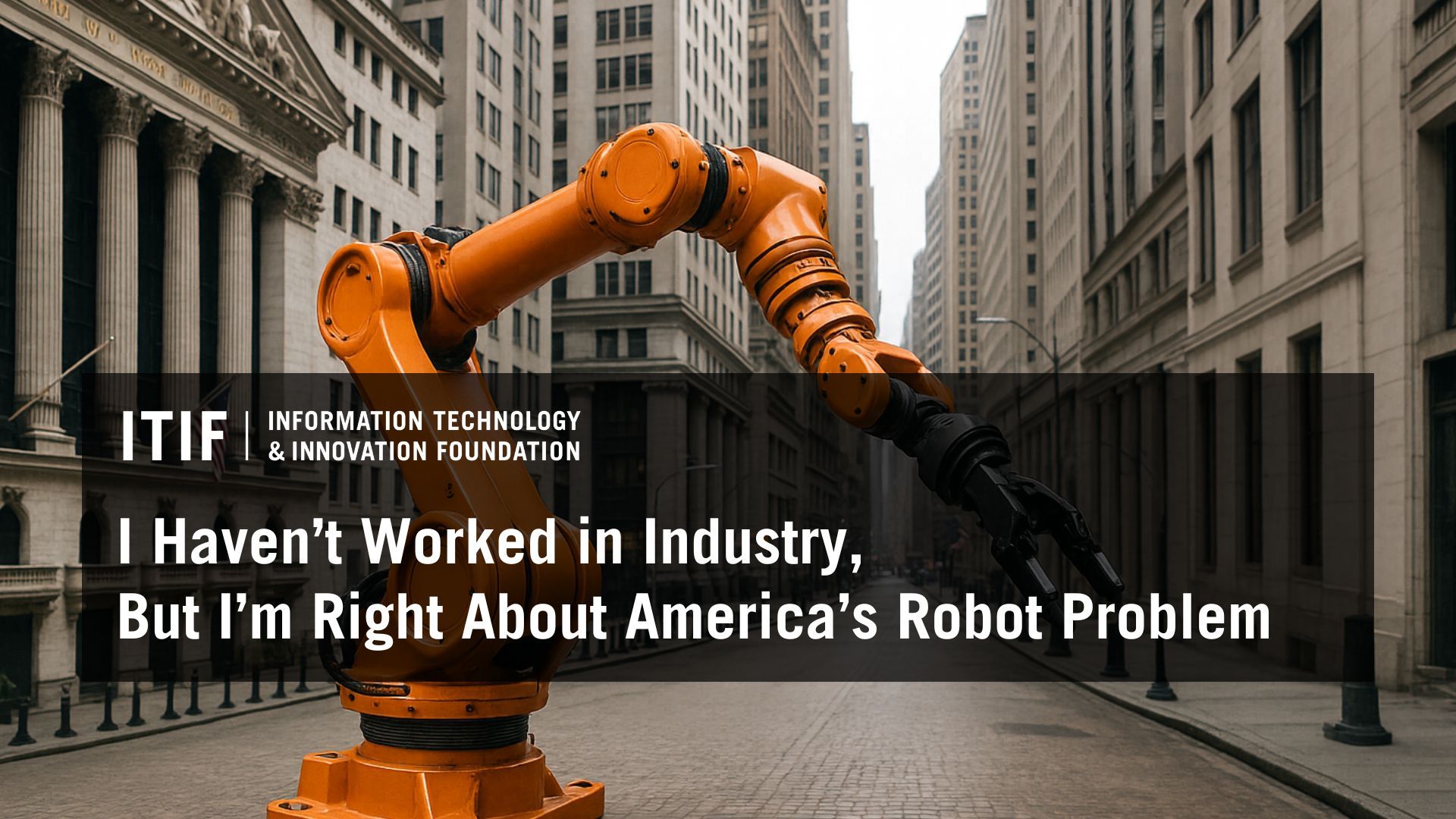I Haven’t Worked in Industry, But I’m Right About America’s Robot Problem – Information Technology and Innovation Foundation

Report on Industrial Automation and its Implications for Sustainable Development Goals
Introduction: A Comparative Analysis of Industrial Robot Adoption and SDG Alignment
A significant disparity exists in the adoption of industrial robotics between the United States and China, with the U.S. lagging considerably. This trend presents critical implications for achieving key Sustainable Development Goals (SDGs), particularly SDG 9 (Industry, Innovation, and Infrastructure) and SDG 8 (Decent Work and Economic Growth). While higher labor costs in the U.S. should theoretically incentivize automation, national strategies and corporate priorities have resulted in China taking a decisive lead, directly impacting global industrial competitiveness and progress towards sustainable industrialization.
Factors Influencing Divergent Adoption Rates
The contrasting approaches to industrial automation are rooted in different national and corporate philosophies, which directly affect the fulfillment of SDG targets.
- People’s Republic of China:
- National Strategic Priority: The Chinese government has designated robot adoption as a national obsession and a core component of its industrial strategy, aligning with SDG 9’s call for building resilient infrastructure and fostering innovation.
- Government Intervention: State-led initiatives, including substantial subsidies and “administrative guidance” for companies, actively promote investment in automation to enhance industrial capacity.
- United States:
- Corporate Financial Strategy: A predominant focus on short-term profitability metrics, such as high return on net assets (RONA), discourages long-term capital investment in robotics. This “capital-lite” approach is misaligned with the objectives of SDG 9.
- Lack of Policy Incentives: The elimination of the investment tax credit for new machinery in 1986 removed a key policy tool for encouraging the technological upgrades necessary for sustainable industrialization (Target 9.4).
- Low Perceived Applicability: A 2023 NSF innovation survey reveals that 55% of U.S. manufacturing companies believe robotics technology is not applicable to their business, indicating a significant barrier to innovation and productivity growth (Target 8.2).
Economic and Sustainable Development Consequences
The U.S. lag in automation investment yields suboptimal outcomes for both the economy and its capacity to meet global sustainability targets.
- Productivity and Economic Growth (SDG 8): The U.S. manufacturing sector has experienced stagnating or declining labor productivity for over a decade. This trend threatens long-term economic growth and the nation’s ability to sustain decent work, a core tenet of SDG 8. In contrast, China’s focus on capital-heavy investment is poised to accelerate its productivity.
- Industrial Innovation and Competitiveness (SDG 9): By underinvesting in automation, the U.S. fails to capture the full societal returns from new capital equipment. Research indicates that companies capture only half of the total societal benefit, meaning the current investment rate is insufficient to drive the broad-based industrial innovation envisioned in SDG 9.
- Global Market Positioning: The combination of relatively low labor costs and strong productivity growth gives Chinese firms a significant advantage in global markets. Without a strategic shift towards automation, the U.S. manufacturing base may face further decline, hindering its role in a sustainable global economy.
Policy Recommendations for Advancing SDGs 8 and 9
To address these challenges and realign with sustainable development objectives, a strategic shift in economic thinking and policy is required.
- Re-evaluate Economic Models: A transition is needed from economic models that prioritize short-term shareholder returns to those that foster long-term national value and sustainable industrial capacity.
- Implement Policy Interventions: Introduce policy mechanisms, such as an investment tax credit, to incentivize corporate investment in robotics and other advanced machinery. This would help correct for market failures and align private sector activity with the goals of SDG 9.
- Foster Public-Private Partnerships (SDG 17): Promote a national strategy that encourages collaboration between government and industry to elevate the importance of automation for achieving sustainable economic growth and industrial resilience.
- Promote and Incentivize Adoption: Utilize public platforms, such as presidential awards and other forms of recognition, to champion companies that invest in automation and encourage a broader cultural shift towards long-term capital investment.
1. Which SDGs are addressed or connected to the issues highlighted in the article?
-
SDG 8: Decent Work and Economic Growth
- The article’s core focus is on economic productivity, particularly within the manufacturing sector. It directly discusses the stagnation and decline of U.S. manufacturing labor productivity over the last 13 years and contrasts it with China’s rapid growth, which is central to the goal of achieving sustainable economic growth. The discussion revolves around how technological adoption (or lack thereof) impacts a nation’s economic output and competitive advantage.
-
SDG 9: Industry, Innovation and Infrastructure
- This goal is prominently featured as the article critiques the U.S. manufacturing industry’s failure to innovate and upgrade its technological capabilities. The entire piece is a commentary on the low adoption rate of industrial robots, which is a key aspect of building resilient infrastructure, promoting sustainable industrialization, and fostering innovation. The article explicitly links the lack of investment in new machinery and robotics to national industrial policy and corporate strategy, which are foundational elements of SDG 9.
2. What specific targets under those SDGs can be identified based on the article’s content?
-
Targets under SDG 8: Decent Work and Economic Growth
- Target 8.2: “Achieve higher levels of economic productivity through diversification, technological upgrading and innovation…”
The article directly addresses this target by lamenting the low rate of technological upgrading in U.S. manufacturing. It argues that the failure to adopt robots leads to stagnating labor productivity, stating, “U.S. manufacturing labor productivity is likely to stagnate or even continue to decline, as it has for the last 13 years.” The author advocates for increased investment in automation as a primary means to boost economic productivity.
- Target 8.2: “Achieve higher levels of economic productivity through diversification, technological upgrading and innovation…”
-
Targets under SDG 9: Industry, Innovation and Infrastructure
- Target 9.2: “Promote inclusive and sustainable industrialization and, by 2030, significantly raise industry’s share of employment and gross domestic product (GDP)…”
The article expresses concern that without technological investment, “U.S. manufacturing” risks “declining even more.” This aligns with the goal of maintaining and strengthening the industrial base’s contribution to the national economy. - Target 9.5: “Enhance scientific research, upgrade the technological capabilities of industrial sectors in all countries… encouraging innovation and substantially increasing… public and private research and development spending.”
This target is central to the article’s argument. The author points to the shockingly low adoption of robotics (“Just 8.3 percent had adopted robots”) as a failure to upgrade technological capabilities. The piece critiques “capital-lite corporate strategies” and the lack of private investment in new capital equipment, which is a direct reflection of this target. - Target 9.b: “Support domestic technology development, research and innovation… including by ensuring a conducive policy environment…”
The article contrasts the policy environments of the U.S. and China. It notes that China provides “massive subsidies” and “administrative guidance” to promote robot adoption, creating a conducive environment. In contrast, it criticizes the U.S. for eliminating the “investment tax credit for installing new machines” and for having a policy environment dominated by “Wall Street pressures for high return on net assets,” which discourages long-term capital investment.
- Target 9.2: “Promote inclusive and sustainable industrialization and, by 2030, significantly raise industry’s share of employment and gross domestic product (GDP)…”
3. Are there any indicators mentioned or implied in the article that can be used to measure progress towards the identified targets?
-
Indicators for SDG 8 Targets
- For Target 8.2: The article directly references a key metric related to Indicator 8.2.1 (Annual growth rate of real GDP per employed person). It states that “U.S. manufacturing labor productivity is likely to stagnate or even continue to decline, as it has for the last 13 years.” This declining productivity rate is a direct measure of progress (or lack thereof) for this target.
-
Indicators for SDG 9 Targets
- For Target 9.5: The article provides a specific, measurable data point that serves as a direct indicator of technological adoption within an industry. It cites the NSF innovation survey, stating, “Just 8.3 percent [of manufacturing companies] had adopted robots.” This percentage is a clear, quantifiable indicator of the level of technological upgrading in the industrial sector.
- Implied Indicator: The article consistently uses the comparative rate of industrial robot adoption between the U.S. and China as a key performance indicator. The opening sentence, “The United States lags far behind China in industrial robot adoption,” establishes this comparison as a primary metric for assessing national industrial innovation and competitiveness.
4. Table of SDGs, Targets, and Indicators
| SDGs | Targets | Indicators Identified in the Article |
|---|---|---|
| SDG 8: Decent Work and Economic Growth | Target 8.2: Achieve higher levels of economic productivity through technological upgrading and innovation. | Directly Mentioned: The rate of manufacturing labor productivity, which has been declining for 13 years in the U.S. (Relates to official indicator 8.2.1). |
| SDG 9: Industry, Innovation and Infrastructure | Target 9.2: Promote sustainable industrialization and raise industry’s share of GDP. | Implied: The potential for U.S. manufacturing to decline further as a share of the economy. |
| Target 9.5: Upgrade the technological capabilities of industrial sectors. | Directly Mentioned: The percentage of manufacturing companies that have adopted robots (8.3%). Implied: The comparative rate of industrial robot adoption between the U.S. and China. |
|
| Target 9.b: Support domestic technology development through a conducive policy environment. | Implied: The existence (or lack) of government policies like an “investment tax credit” or subsidies for technology adoption. |
Source: itif.org
What is Your Reaction?
 Like
0
Like
0
 Dislike
0
Dislike
0
 Love
0
Love
0
 Funny
0
Funny
0
 Angry
0
Angry
0
 Sad
0
Sad
0
 Wow
0
Wow
0
















































/environment-climate-change-and-health-(ech)/water-sanitation-hygiene-and-health-(wsh)/landfill-tuvalu-36092.tmb-1200v.jpg?sfvrsn=5c21fe40_1#)

.jpg.webp?itok=0ZsAnae9#)

























